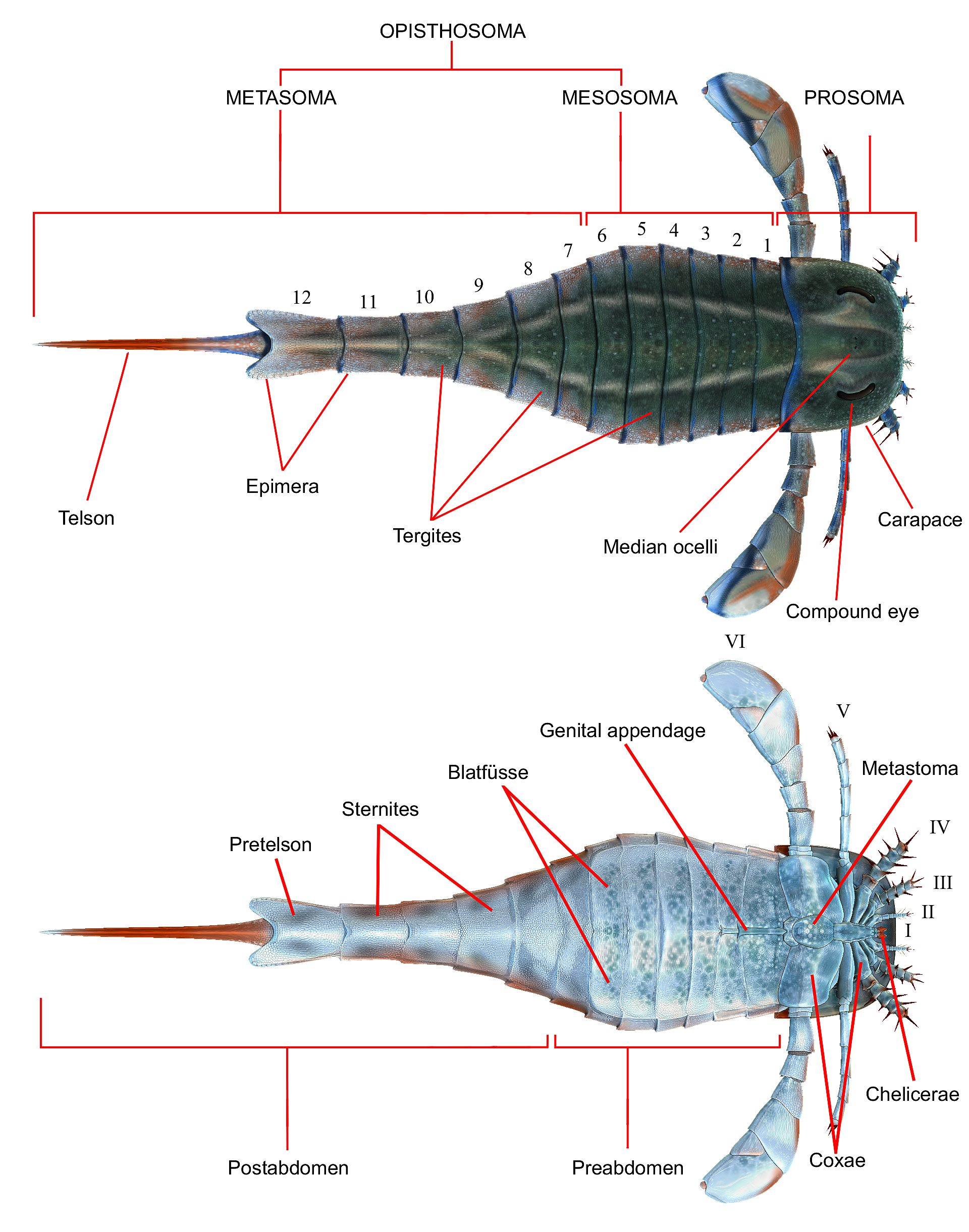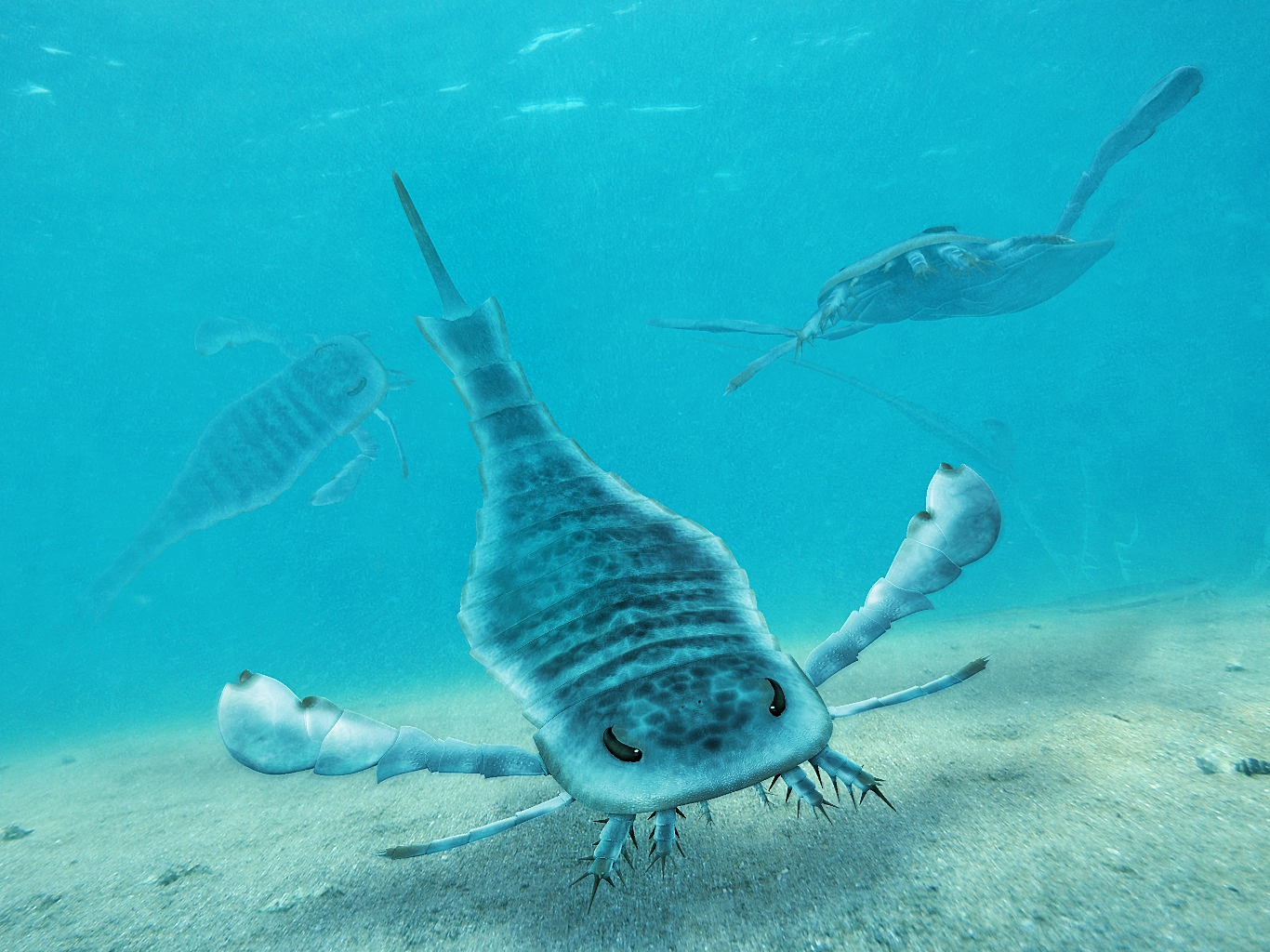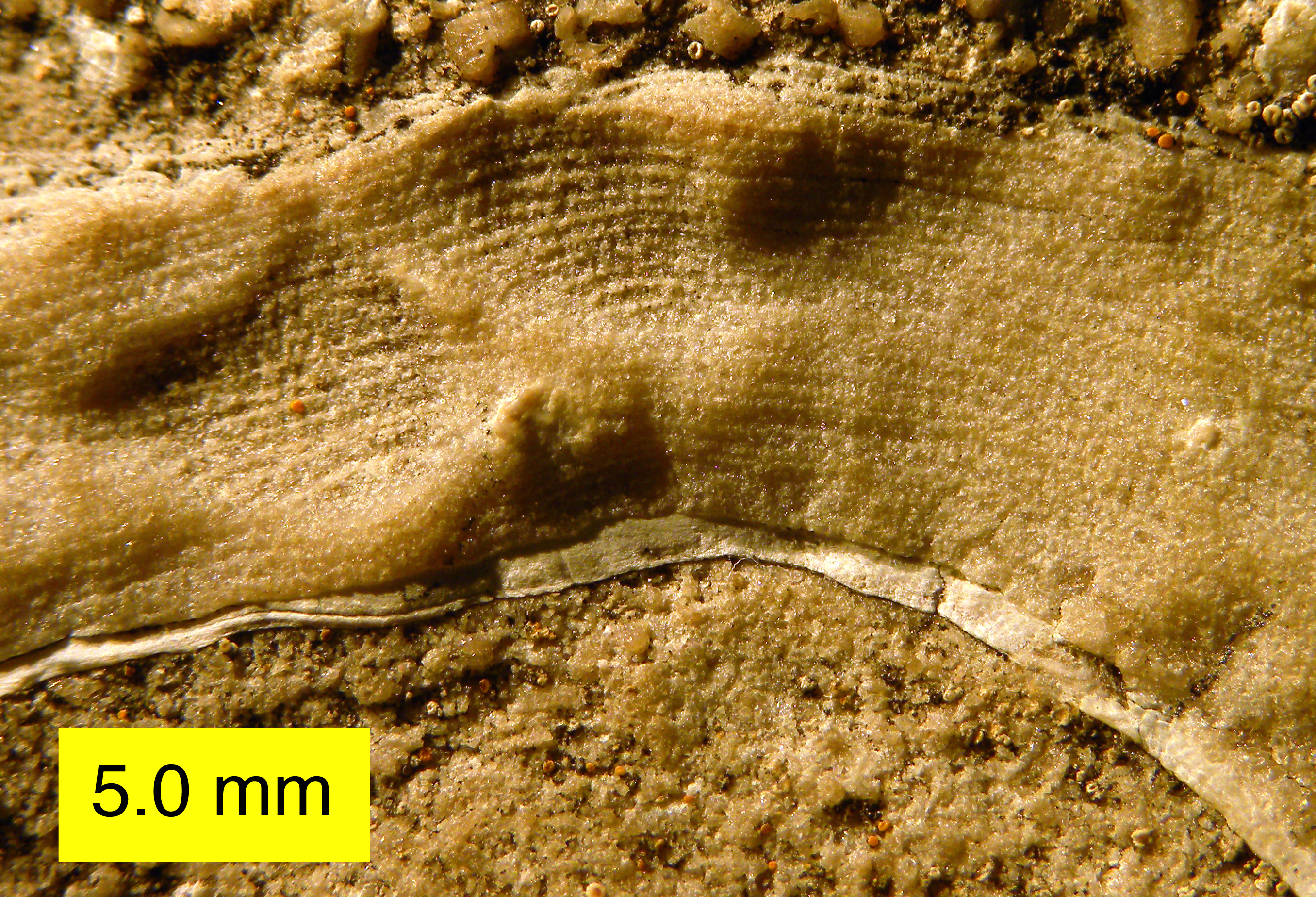|
Eurypterids
Eurypterids, often informally called sea scorpions, are a group of extinct marine arthropods that form the order Eurypterida. The earliest known eurypterids date to the Darriwilian stage of the Ordovician period, 467.3 million years ago. The group is likely to have appeared first either during the Early Ordovician or Late Cambrian period. With approximately 250 species, the Eurypterida is the most diverse Paleozoic chelicerate order. Following their appearance during the Ordovician, eurypterids became major components of marine faunas during the Silurian, from which the majority of eurypterid species have been described. The Silurian genus ''Eurypterus'' accounts for more than 90% of all known eurypterid specimens. Though the group continued to diversify during the subsequent Devonian period, the eurypterids were heavily affected by the Late Devonian extinction event. They declined in numbers and diversity until becoming extinct during the Permian–Triassic extinction event ... [...More Info...] [...Related Items...] OR: [Wikipedia] [Google] [Baidu] |
Eurypterus
''Eurypterus'' ( ) is an extinct genus of eurypterid, a group of organisms commonly called "sea scorpions". The genus lived during the Silurian period, from around 432 to 418 million years ago. ''Eurypterus'' is by far the most well-studied and well-known eurypterid. ''Eurypterus'' fossil specimens probably represent more than 95% of all known eurypterid specimens. There are fifteen species belonging to the genus ''Eurypterus'', the most common of which is ''E. remipes'', the first eurypterid fossil discovered and the List of U.S. state fossils, state fossil of New York (state), New York. Members of ''Eurypterus'' averaged at about in length, but the largest individual discovered was estimated to be long. They all possessed spine-bearing appendages and a large paddle they used for swimming. They were Generalist and specialist species, generalist species, equally likely to engage in predation or scavenging. Discovery The first fossil of ''Eurypterus'' was found in 1818 by S ... [...More Info...] [...Related Items...] OR: [Wikipedia] [Google] [Baidu] |
Dorfopterus
''Dorfopterus'' is a genus of eurypterid, a group of extinct aquatic arthropods. Only one fossil of the single and type species, ''D. angusticollis'', has been discovered in Deposition (geology), deposits of the Early Devonian Period (geology), period (Emsian Stage (stratigraphy), stage) in the Beartooth Butte Formation in Wyoming, in the United States. The first half of the name of the genus honors the discoverer of this formation, Erling Dorf, while the second half consists in the Ancient Greek word wiktionary:πτερόν#Ancient Greek, πτερόν (''pteron''), meaning "wing". The species name ''angusticollis'' is composed by the Latin words ''wiktionary:angustus#Latin, angustus'' ("narrow") and ''wiktionary:collum#Latin, collum'' ("neck"). The only known specimen of ''Dorfopterus'' consists of an incomplete uncrushed telson (the posteriormost division of the body), which was long, narrow, styliform and with a central carina ("keel"). It had a special Biological ornament, or ... [...More Info...] [...Related Items...] OR: [Wikipedia] [Google] [Baidu] |
Stylonurina
Stylonurina is one of two suborders of eurypterids, a group of extinct arthropods commonly known as "sea scorpions". Members of the suborder are collectively and informally known as "stylonurine eurypterids" or "stylonurines". They are known from deposits primarily in Europe and North America, but also in Siberia. Compared to the other suborder, Eurypterina, the stylonurines were comparatively rare and retained their posterior prosomal appendages for walking. Despite their rarity, the stylonurines have the longest temporal range of the two suborders. The suborder contains some of the oldest known eurypterids, such as ''Brachyopterus'', from the Middle Ordovician as well as the youngest known eurypterids, from the Late Permian. They remained rare throughout the Ordovician and Silurian, though the radiation of the mycteropoids (a group of large sweep-feeding forms) in the Late Devonian and Carboniferous is the last major radiation of the eurypterids before their extinction in the Pe ... [...More Info...] [...Related Items...] OR: [Wikipedia] [Google] [Baidu] |
Eurypterina
Eurypterina is one of two suborders of eurypterids, an extinct group of chelicerate arthropods commonly known as "sea scorpions". Eurypterine eurypterids are sometimes informally known as "swimming eurypterids". They are known from fossil deposits worldwide, though primarily in North America and Europe. Seventy-five percent of eurypterid species are eurypterines; this represents 99% of specimens. The superfamily Pterygotioidea is the most species-rich clade, with 56 species, followed by the Adelophthalmoidea with 43 species; as sister taxa, they comprise the most derived eurypterines. Pterygotioidea includes the pterygotids, which are the only eurypterids known to have a cosmopolitan distribution. Though more numerous both in specimens and taxa, the eurypterines have the shorter temporal range of the two eurypterid suborders. They first appeared around the same time as the Stylonurina in the Middle Ordovician. The suborder faced a slow extinction during the Middle and Lat ... [...More Info...] [...Related Items...] OR: [Wikipedia] [Google] [Baidu] |
Chelicerata
The subphylum Chelicerata (from Neo-Latin, , ) constitutes one of the major subdivisions of the phylum Arthropoda. Chelicerates include the sea spiders, horseshoe crabs, and arachnids (including harvestmen, scorpions, spiders, solifuges, ticks, and mites, among many others), as well as a number of extinct lineages, such as the eurypterids (sea scorpions) and chasmataspidids. Chelicerata split from Mandibulata by the mid-Cambrian, as evidenced by stem-group chelicerates like Habeliida and '' Mollisonia'' present by this time. The surviving marine species include the four species of xiphosurans (horseshoe crabs), and possibly the 1,300 species of pycnogonids (sea spiders), if the latter are indeed chelicerates. On the other hand, there are over 77,000 well-identified species of air-breathing chelicerates, and there may be about 500,000 unidentified species. Like all arthropods, chelicerates have segmented bodies with jointed limbs, all covered in a cuti ... [...More Info...] [...Related Items...] OR: [Wikipedia] [Google] [Baidu] |
Marsupipterus
''Marsupipterus'' is a genus of prehistoric eurypterid with an uncertain classification. The genus contains one species, ''Marsupipterus sculpturatus'', from the Silurian of England England is a Countries of the United Kingdom, country that is part of the United Kingdom. It is located on the island of Great Britain, of which it covers about 62%, and List of islands of England, more than 100 smaller adjacent islands. It ....Dunlop, J. A., Penney, D. & Jekel, D. 2015. A summary list of fossil spiders and their relatives. In World Spider Catalog. Natural History Museum Bern, online at http://wsc.nmbe.ch , version 16.0 http://www.wsc.nmbe.ch/resources/fossils/Fossils16.0.pdf (PDF). See also * List of eurypterids References Eurypterida Silurian eurypterids Fossils of Sweden Eurypterids of Europe Fossil taxa described in 1955 {{eurypterid-stub ... [...More Info...] [...Related Items...] OR: [Wikipedia] [Google] [Baidu] |
Scorpion
Scorpions are predatory arachnids of the Order (biology), order Scorpiones. They have eight legs and are easily recognized by a pair of Chela (organ), grasping pincers and a narrow, segmented tail, often carried in a characteristic forward curve over the back and always ending with a stinger. The evolutionary history of scorpions goes back Silurian, 435 million years. They mainly live in deserts but have adapted to a wide range of environmental conditions, and can be found on all continents except Antarctica. There are over 2,500 described species, with 22 extant (living) families recognized to date. Their Taxonomy (biology), taxonomy is being revised to account for 21st-century genomic studies. Scorpions primarily prey on insects and other invertebrates, but some species hunt vertebrates. They use their pincers to restrain and kill prey, or to prevent their own predation. The Scorpion sting, venomous sting is used for offense and defense. During courtship, the male and female ... [...More Info...] [...Related Items...] OR: [Wikipedia] [Google] [Baidu] |
Brackish Water
Brackish water, sometimes termed brack water, is water occurring in a natural environment that has more salinity than freshwater, but not as much as seawater. It may result from mixing seawater (salt water) and fresh water together, as in estuary, estuaries, or it may occur in brackish Fossil water, fossil aquifers. The word comes from the Middle Dutch root '':wikt:brak#Dutch, brak''. Certain human activities can produce brackish water, in particular civil engineering projects such as dikes and the flooding of coastal marshland to produce brackish water pools for freshwater prawn farming. Brackish water is also the primary waste product of the Osmotic power, salinity gradient power process. Because brackish water is hostile to the growth of most terrestrial plant species, without appropriate management it can be damaging to the environment (see article on shrimp farming, shrimp farms). Technically, brackish water contains between 0.5 and 30 grams of salt per litre—more ofte ... [...More Info...] [...Related Items...] OR: [Wikipedia] [Google] [Baidu] |
Marine Life
Marine life, sea life or ocean life is the collective ecological communities that encompass all aquatic animals, aquatic plant, plants, algae, marine fungi, fungi, marine protists, protists, single-celled marine microorganisms, microorganisms and associated marine virus, viruses living in the saline water of marine habitats, either the sea water of marginal seas and oceans, or the brackish water of coastal wetlands, lagoons, estuary, estuaries and inland seas. , more than 242,000 marine species have been documented, and perhaps two million marine species are yet to be documented. An average of 2,332 new species per year are being described. Marine life is studied scientifically in both marine biology and in biological oceanography. By volume, oceans provide about 90% of the living space on Earth, and served as the cradle of life and vital biotic sanctuaries throughout Earth's geological history. The earliest known life forms evolved as anaerobe, anaerobic prokaryotes (archaea ... [...More Info...] [...Related Items...] OR: [Wikipedia] [Google] [Baidu] |
Permian–Triassic Extinction Event
The Permian–Triassic extinction event (also known as the P–T extinction event, the Late Permian extinction event, the Latest Permian extinction event, the End-Permian extinction event, and colloquially as the Great Dying,) was an extinction event that occurred approximately 251.9 Million years ago, million years ago (mya), at the boundary between the Permian and Triassic geologic periods, and with them the Paleozoic and Mesozoic eras. It is Earth's most severe known extinction event, with the extinction of 57% of Family (biology), biological families, 62% of genera and 81% of marine biology, marine species, (previous estimates of 90–96% marine species extinction were due to historical conflation with the End-Capitanian mass extinction event, end-Capitanian mass extinction which occurred 7–10 million years earlier) and 70% of terrestrial vertebrate species. It is also the greatest known mass extinction of insects. It is the greatest of the "Big Five" mass extinctions of t ... [...More Info...] [...Related Items...] OR: [Wikipedia] [Google] [Baidu] |
Late Devonian Extinction Event
The Late Devonian mass extinction, also known as the Kellwasser event, was a mass extinction event which occurred around 372 million years ago, at the boundary between the Frasnian and Famennian ages of the Late Devonian period.Racki, 2005McGhee, George R. Jr, 1996. The Late Devonian Mass Extinction: the Frasnian/Famennian Crisis (Columbia University Press) It is placed as one of the "Big Five" most severe mass extinction events in Earth's history, with likely around 40% of marine species going extinct, though the degree of severity is contested. A second mass extinction called the Hangenberg event, also known as the end-Devonian extinction, occurred 13 million years later around 359 million years ago, bringing an end to the Famennian and Devonian, as the world transitioned into the Carboniferous Period. The effects of the two extinction events have historically been conflated, and both events collectively profoundly reshaped marine ecosystems. Although it is well established ... [...More Info...] [...Related Items...] OR: [Wikipedia] [Google] [Baidu] |








